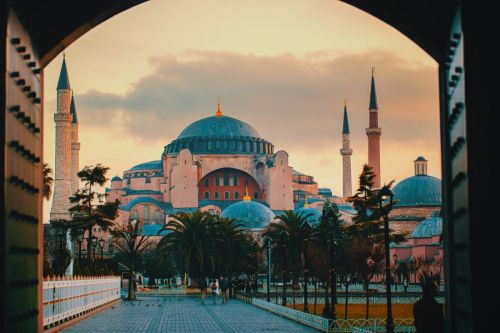Pamukkale is a geographically and historically unique place located in western Turkey, known mainly for its white terraced pools and cascades. It is one of the country’s most iconic sites and is awe-inspiring for its extraordinary beauty and history. Known in Turkish as “Cotton Castle,” it rises from the ground like a dreamy kingdom.
Pamukkale is not only a natural wonder of white terraces and pools, but also the historic ruins of the ancient city of Hierapolis, which flourished here thousands of years ago. The globally unique site has been listed as a UNESCO World Heritage Site.
It lies in the valley of the Meander River, near the ancient archaeological site of Laodicea on the Lycus, a dozen kilometers northeast of the city of Denizli.
It is a natural and tourist site, famous for the limestone deposits formed on the slope of the Cökelez mountain, which have formed white terraced pools and cascades. The Turkish authorities have protected the area by creating a national park, listed as a UNESCO World Heritage Site in 1988.
The connotation stems from the fact that there are extensive cotton plantations nearby, as eastern Anatolia is an agricultural area where, among other things, cotton is grown. Pamukkale is as white as cotton. Covering the slope of the Cökelez mountain, the limestone deposits from which travertine (a calcareous sedimentary rock formed around mineral springs) was formed is a natural wonder in white.
They bring water from 35 degrees Celsius to nearly 100 degrees Celsius to the surface. The water coming to the surface, saturated with calcium carbonate and carbon dioxide, cools down and degasses, and the calcium carbonate in the form of a gel is deposited to crystallize after some time.
As a result of this process, unique stalactites, waterfalls, sills, and elliptical pools of thermal water preceded by dams have formed on the slope of Mount Cökelez, where water has been flowing for about 14.000 years. It is estimated that the travertines are currently 160 meters thick and extend over an area of 2700 meters and 600 meters wide.
It was already appreciated by the Romans, who, in addition to its health properties, recognized its ability to slow down the aging process. Today, the water is claimed to have salutary effects on eyesight and skin disorders, treat asthma and rheumatic pain, as well as hypertension, circulation problems, and indigestion. It also increases the level of endorphins, which influences well-being.
On the subject of the unique properties of Pamukkale thermal waters there is also a legend, according to which in the vicinity of the town lived a very ill-bred girl who had no chance of getting married. Since all her female friends had found husbands and she was still alone, she decided to commit suicide by throwing herself off a travertine terrace. However, she fell into a pit filled with water and lost consciousness. A prince passed by there and saw the beautiful girl lying in the water. He fell in love with her without memory and married her. It turned out that the water from the thermal pools could transform an ugly girl into a beauty. This legend, which is readily told to tourists, serves to encourage them to take advantage of the healthful beauty baths.
The Romans also made use of travertine, which was used as building blocks for statues and vessels.
One of them tells of a shepherd named Endymion, who grazed his herd of cows and sheep on the slope of Mount Cökelez. One day he was spotted by the moon goddess Selene, who fell in love with the shepherd. In love with each other, the couple spent a lot of time together and were so consumed by love that Endymion forgot about his flock, which was patiently waiting to be milked. Legend has it that the shepherd never milked his cows, and the milk that flowed from their udders melted away to form a milky-white landscape.
Hierapolis was founded as a thermal spa in the early 2nd century BC. It became a healing center where doctors used thermal springs to treat their patients.
It got its name Hierapolis - the holy city - because of the large number of templates in its area. A church was founded there (under the influence of the Apostle Paul) while he was in Ephesus. The Apostle Philip spent the last years of his life in Hierapolis, and, likely, a city martyrium (a sacred building dedicated to a martyr, usually hiding his tomb or relics) was built on the site of his crucifixion, which took place in 80 AD. It is also said that his daughters acted as prophetesses in the area.
The city gained its present shape in the year 60, during the reign of Nero when it was rebuilt after a strong earthquake. The city was experiencing its golden age. Thousands of people enjoyed the healing properties of the hot springs. Hierapolis became one of the most important cities of the Roman Empire in art, philosophy, and trade.
In 1354 a great earthquake destroyed the ancient city. Hierapolis was first excavated in 1887.
Numerous hotels were built there, which contributed to environmental degradation. The exploitation of the limestone water by the hotels caused extensive damage visible in the form of gray, dried-up terraces. The route through the natural pools was closed in 1997. Today, about 10 pools are open to the public, and it is only possible to enter the travertine without footwear. The Turkish authorities, wanting to protect the area and seeking to have Pamukkale listed as a UNESCO World Cultural and Natural Heritage Site, were forced to close down the hotels and introduce several restrictions on the use of the site.
Pamukkale, along with Hierapolis, was listed as a UNESCO World Heritage Site in 1988.
This water was imported for her, and after bathing she claimed that her skin became much softer, hydrated, and rejuvenated.
Cleopatra’s pool still exists in Hierapolis today. It is located between the building of the Great Baths and the Nymphaeum. It is a thermal water pool that was already in operation during the heyday of Hierapolis when it was a famous spa. Legend has it that his pool was a gift to the ruler of Egypt from Mark Antony.
In ancient times, the pool was surrounded by Ionic-style columns, which collapsed during an earthquake in the seventh century. Their remains rest at the bottom of the pool and tourists today, for whom the pool is open to the public, can bathe in it among the ancient columns.
The trend was started by Marmaris and Tugrul from Turkey in 2009, celebrating their wedding there.
The theater was probably built during the reign of Hadrian, after an earthquake in 60 AD. It has a two-story stage, of which only the lower level has survived to the present day.
Sick people who came in large numbers to Hierapolis for treatment did not always return home. Some did not recover and their bodies were buried in the local cemetery. The dead were buried in three places: north, south, and east of the city, a short distance from St. Paul’s martyrium.






